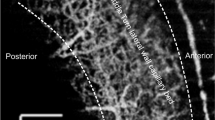Abstract
To elucidate the etiology and pathogenesis of sudden hearing loss, the effect of experimental cochlear thrombosis on oxygenation and the auditory function of the inner ear was investigated in anesthetized guinea pigs. Impairment of cochlear blood flow (CBF) was induced by ferromagnetic obstruction of cochlear blood vessels at lowered body temperature. Perilymphatic oxygen partial pressure (PO2) in the basal scala tympani (about 200 μm below the round window membrane) was measured polarographically using micro-coaxial needle electrodes. Auditory function was examined by recording cochlear microphonic (CM) frequency responses, compound action potentials (CAP) and auditory evoked brainstem responses (ABR). Findings demonstrated a considerable decrease in the mean perilymphaticPO2 of 40%, 2 h after the start of the experiment. Mean CM and N1 CAP amplitudes were reduced by about 25% each and ABR by 18%. No significant changes were observed in the latencies of either CAP or ABR. Mean basal CBF was found to decrease by 35%, as measured by laser Doppler flowmetry in a parallel study. The present findings demonstrate that vascular impairment in the inner ear results in a considerable drop in intracochlear oxygenation, causing a significant loss in the auditory response.
Similar content being viewed by others
References
Baumgärtl H, Lübbers DW (1983) Microcoaxial needle sensor for polarographic measurement of local O2 pressure in the cellular range of living tissue — its constructions and properties. In: Gnaiger E, Forstner H (eds) Polarographic oxygen sensors: aquatic and physiological applications. Springer, Berlin Heidelberg New York, pp 37–65
Bohne B-D, Rolle W, Strobl R, Ulrich W-D (1973) MantelThermoelemente zur Temperaturmessung in Medizin und Biologie. Medizintechnik 13:13–16
Giebel W, Schmidt G, Galic M, Winkler B (1985) Occlusion of inner ear vessels by magnetic forces applied to circulating metallic iron particles. Arch Otorhinolaryngol 242:329–335
Giebel W, Strömer H, Arold R (1992) Experimentelle Untersuchungen zur Ischämie der Cochlea. I. Methodik. Laryngorhinootologie 71:161–167
Haupt H, Scheibe F, Ludwig C (1993) Changes in cochlear oxygenation, microcirculation and auditory function during prolonged general hypoxia. Eur Arch Otorhinolaryngol 250:396–400
Lawrence M, Nuttall AL (1972) Oxygen availability in the tunnel of Corti measured by microelectrode. J Acoust Soc Am 52:566–573
Lawrence M, Nuttall AL, Burgio PA (1975) Cochlear potentials and oxygen associated with hypoxia. Ann Otol Rhinol Laryngol 84:499–512
Lawrence M, Nuttall AL, Burgio PA (1977) Oxygen reserve and autoregulation in the cochlea. Acta Otolaryngol (Stockh) 83:146–152
Maass B, Baumgärtl H, Lübbers DW (1976) LokalepO2-Mes-sungen mit Nadelelektroden zum Studium der Sauerstoffversorgung und Mikrozirkulation des Innenohres. Arch Otorhinolaryngol 214:109–124
Maass B, Baumgärtl H, Lübbers DW (1978) LokalePO 2 − undPH2-Messungen mit Mikrokoaxialnadelelektroden an der Basalwindung der Katzencochlea nach akuter oberer zervikaler Sympathektomie. Arch Otorhinolaryngol 221:269–284
Mayahara T, Perlman HB (1972) Cochlear microcirculation and oxygen transport. Laryngoscope 82:578–597
Prazma J (1982) Perilymphatic and endolymphaticpO2-variations during anoxia, hyperoxia, and hypercapnia. Arch Otolaryngol 108:539–543
Scheibe F, Ludwig C, Haupt H, Flemming B (1989) Physiologische Parameter des Meerschweinchens unter Langzeitnarkose mit kontrollierter Beatmung. Z Versuchstierkd 32:25–31
Scheibe F, Haupt H, Ludwig C (1992) Intensity-dependent changes in oxygenation of cochlear perilymph during acoustic exposure. Hear Res 63:19–25
Scheibe F, Haupt H, Ludwig C (1993) Intensity-related changes in cochlear blood flow in the guinea pig during and following acoustic exposure. Eur Arch Otorhinolaryngol 250:281–285
Scheibe F, Haupt H, Grunert H (1997) Laser Doppler measurements of inner ear blood flow during experimental thrombosis of cochlear blood vessels in the guinea pig. Eur Arch Otorhinolaryngol 254:86–90
Thorne PR, Nuttall AL (1987) Laser Doppler measurements of cochlear blood flow during loud sound exposure in the guinea pig. Hear Res 27:1–10
Thorne PR, Nuttall AL (1989) Alterations in oxygenation of cochlear endolymph during loud sound exposure. Acta Otolaryngol (Stockh) 107:71–79
Wagner H, Berndt H, Gerhardt HJ (1974) Zur Erzeugung kalibrierter Schallpegel am Trommelfell des Meerschweinchens. Arch Otorhinolaryngol 206:283–292
Author information
Authors and Affiliations
Rights and permissions
About this article
Cite this article
Scheibe, F., Haupt, H. & Baumgärtl, H. Effects of experimental cochlear thrombosis on oxygenation and auditory function of the inner ear. Eur Arch Otorhinolaryngol 254, 91–94 (1997). https://doi.org/10.1007/BF01526187
Received:
Accepted:
Issue Date:
DOI: https://doi.org/10.1007/BF01526187




